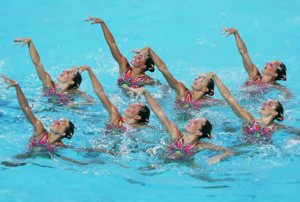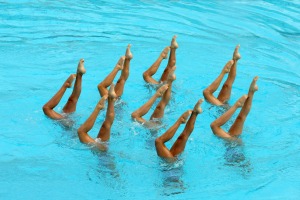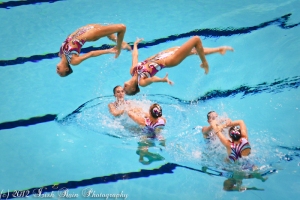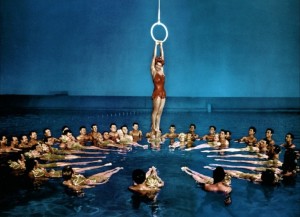Synchronized swimming has truly developed as a sport through the ages from its original water ballet performances to its recognition on the Olympic committee as a sport worthy of global recognition and competition. Synchronized Swimming is a very difficult and intricate sport requiring a lot from the athlete both physically and mentally. Synchronized swimming, or synchro to those more familiar with the sport, consists of one to ten swimmers swimming choreography in a pool to music while all staying synchronized with each other and the music. Routines are comprised of both above and underwater sections; the above water sections are called “arms” and consist of leg movements done while lying across the surface of the water, and arm movements.
 Arm (Russia’s Olympic Team 2004) (http://synchronizedswimmingblog.com/wp-content/uploads/2014/11/synchronised-swimming-1.jpg)
Arm (Russia’s Olympic Team 2004) (http://synchronizedswimmingblog.com/wp-content/uploads/2014/11/synchronised-swimming-1.jpg)
As for the underwater sections, those are called either “figures”, or “highlights”. Figures are the movements made with the legs above the water while the body is upside down in the water.
 Figure (Spain’s Olympic Team 2012) (http://www.zastavki.com/pictures/originals/2014/Sport_Synchronized_swimming_085244_.jpg)
Figure (Spain’s Olympic Team 2012) (http://www.zastavki.com/pictures/originals/2014/Sport_Synchronized_swimming_085244_.jpg)
Highlights, however, are anything that draw the eye of the viewers so these could be boosts, which is when an athlete is lifted or launched out of the water, or a partner lift, which is the same as a boost except with 2-4 swimmers instead of the whole team. Both of these highlights can be done with the athlete moving head or feet first; it is up to the coach to decide what fits best into the choreography and theme of the routine. (http://www.fina.org/H2O/index.php?option=com_content&view=category&id=86%3Asynchronised-swimming-rules&Itemid=184)
Boosts (At the 2012 London Olympics)
This is a double boost, so two are going off at the same time
A.1 Accessories Required For Synchronized Swimming
Synchro also requires certain accessories for competitions such as a swimsuit designed specifically for the routine being swum, a nose clip to stop water from going up the athletes’ noses while they are upside down, various hair supplies with the goal of putting the athlete’s’ hair into a bun, gelatin to keep hair out of the athletes’ faces while competing, makeup to help add to the suit and theme, and finally music along with both above and below water speakers. All these added together help create a theme for the routine. The above and below water speakers allow the athletes to keep time with the music and counts as well as stay synchronized with the music and each other. For practices there are many other accessories necessary such as head caps, goggles, practice swimsuits, stretchy bands for flexibility training, a water bottle to stay hydrated, and on the odd occasion toe pointers to assist swimmers attain the desired aesthetic foot position. (http://www.fina.org/H2O/index.php?option=com_content&view=article&id=345%3Ass-13-routine-sessions&catid=86%3Asynchronised-swimming-rules&Itemid=184)
 Nose clip used by synchronized swimmers to block out water when upside down. (http://i.ebayimg.com/00/s/NTAwWDQ0NA==/z/eMgAAMXQEgpTBNdV/$_35.JPG)
Nose clip used by synchronized swimmers to block out water when upside down. (http://i.ebayimg.com/00/s/NTAwWDQ0NA==/z/eMgAAMXQEgpTBNdV/$_35.JPG)
A.2 Synchronized Swimming Events and Judging
Synchronized swimming itself consists of 3 main events: solo, duet and team. Solos consist of a single swimmer in the pool swimming synchronized to the music and their theme, duets are with two swimmers who are synchronized with each other as well as with the music, and finally a team which consists of usually 4-8 swimmers synchronizing with each other and again with the music. (http://www.fina.org/H2O/index.php?option=com_content&view=article&id=345%3Ass-13-routine-sessions&catid=86%3Asynchronised-swimming-rules&Itemid=184) Synchro is marked by judges who give scores from zero to ten in two categories: technical merit and artistic interpretation. Technical merit is comprised of execution which is the perfection of swimming strokes, propulsion techniques, figures, patterns and transitions, synchronization which is based on the swimmer’s ability to synchronize with the other swimmers as well as the music, and finally difficulty. Difficulty is evaluated based on the height of movements above the water, complexity and multiplicity of movements, the strength required to perform the movements, length of time of movements and complexity of synchronization. Then there is artistic impression which is composed of choreography which is evaluated based on the variety and creativity of movements, transitions, fluidity, patterns and pool usage, music interpretation, manner of presentation which is the poise with which the routine is presented, ability to communicate through the choreography and seeming effortlessness of the performance. These two categories are what the judges mark on with half the judges marking technical merit and the other half marking artistic impression and are what coaches and choreographers pay attention to when creating the routines. ( Lord, C. (2008)) Routines last anywhere from two to five minutes of performing at lactic acid threshold by all athletes on the team to make the routine appear effortless and flawless. One of the hardest aspects of synchro is even though the athletes are pushing themselves to and past lactic acid threshold, they still have to keep a smile plastered on their face no matter what. “Ever been kicked in the face or in the head, but had to keep on swimming with that fake plastic smile?” said a commenter on http://www.thetoptens.com/hardest-sports/synchronized-swimming-464503.asp describing a synchro swimmers average practice.
Here is a visual of all the elements of synchronized swimming that are explained above. This is Canada’s Olympic Team swimming at the London 2012 Olympics.
A.3 History of The Development of Synchronized Swimming As a Sport
Now here is some history of the development of synchronized swimming as a sport throughout the ages and how it has developed into the sport it is present day.
Synchronized swimming, like many other sports out there, did not start out as it is today, it evolved over time and with the help of many pioneers. One of the American founding fathers, Benjamin Franklin, was actually a pioneer for synchronized swimming and is thought to have possibly invented it. Franklin grew up in Boston, Massachusetts and swam frequently in the Atlantic Ocean to experiment with exercise and its health benefits. He performed manoeuvres he called “ornamental swimming” for spectators in the Thames River on a trip to London in 1724 which people believe lead to the appearance of the sport. We are unsure as to whether Franklin was the actual creator of synchro but he most definitely increased the popularity of swimming which contributed to its invention. (http://synchroswim.isport.com/synchronized-swimming-guides/history-of-synchronized-swimming).
Synchro originally started as a primarily male dominated sport but then became a more female dominant sport since women’s bodies are more buoyant in the legs causing women to be able to make better pictures on the surface of the water with their bodies. It developed from ornamental swimming and into a recognized sport in the late 19th and early 20th centuries with swimmers performing round-dances in the water as a swimming art form. The first contests were held in Berlin in 1891 and in London in 1892 but were only for men. It was not until after this that females were accepted as being more suitable for the sport. ( Lord, C. (2008))
The early competitions were called “water ballet competitions” and it was not until after these competitions that the sport was named “synchronized swimming”. These competitions also caused synchro clubs to start popping up in Australia, the USA, Canada, and France with the intent of hosting and competing in these competitions. Modern synchronized swimming was invented by Annette Kellerman, an Australian-born actor and swimmer who was a champion in distance swimming, and diving. She was also a practiced ballerina throughout the early 1900’s and caused quite an uproar in the media when she went to a beach in Boston, Massachusetts wearing a one piece swimsuit that did not cover her arms or legs. Again in 1907 Kellerman caused more uproar in her fabulous one piece swimsuit while performing underwater in a large glass tank at the New York Hippodrome. Kellerman opened the door for women to be more comfortable with their bodies and showing them off. Her performance in New York added to the rising popularity of synchro and raised lots of awareness for the sport.
Over the next 30 years more and more countries began developing synchro clubs as well as college teams, one of the most famous venues being the University of Chicago’s water ballet club, started by Katherine Curtis. “In 1934, sixty of Curtis’ Modern Mermaids swam in the lagoon at the Century of Progress World’s Fair in Chicago using what they called, “a combination of strokes, tricks and floating formations.”
(http://www.internationalposter.com/pimages/USX09759z.jpg)
The act received rave reviews. The announcer at the event inadvertently named the sport when he called the performance “synchronized swimming.”” (http://synchroswim.isport.com/synchronized-swimming-guides/history-of-synchronized-swimming) After this momentous development in the sport’s history aqua shows became more popular as a form of entertainment though it was still recognized as a sport as well.
(http://synchroswim.isport.com/synchronized-swimming-guides/history-of-synchronized-swimming) Synchro also had its time in the spotlight when Hollywood discovered Ester Williams, a swimming champion and Olympic contender.
Esther Williams in “Million Dollar Mermaid”
(http://askmissa.com/wp-content/uploads/2013/07/esther-williams-1024×744.jpg)
Esther Williams did movies involving synchronized swimming and featuring herself as the lead role. These films included elaborate sets, water slides, fountains, and stages that emerged from the pools and involved many swimmers in the water at once. It was also common for men to be swimming along with Williams in her films and it wasn’t until after the films started appearing that the sport became almost entirely a women’s sport. It was Esther Williams fame on screen that made a place for synchro in American pop culture in the 1940’s and 50’s. (http://synchroswim.isport.com/synchronized-swimming-guides/history-of-synchronized-swimming)
In the 1940’s competition in the United States heated up and synchronized swimming was officially adopted into the Amateur Athletic Union as a competitive sport, including both a team and duet category. In 1942 the first attempt at a National Championships was held but only three clubs showed up and they were all from Chicago. In the 1950’s a solo competition category was added and it was a Canadian named June Taylor, from Ontario, who was named the first solo champion in the Indoor event. These US National Championships were held twice a year, once indoor and once outdoor until 1990 when they started only doing one a year regardless of the pool type, whether it be indoor or outdoor.
International competitions were also occurring annually with the first World Aquatic Championship being held in Belgrade, Yugoslavia in 1971, which North America dominated. The synchronized swimming community had its sights on having the sport included in the Olympics so in 1952 the US and Canadian teams performed at the Pan American Games in Buenos Aires, Argentina. They also performed at the 1952 Olympics in Helsinki, Finland as well as in the 1955 Pan American Games in Mexico City where Mexico decided to include synchronized swimming as an official event but the International Olympic Committee was not convinced. The US team did a lot more demonstrations including one at the Rome Olympics in 1960 meanwhile at home more and more national competitions from age group and junior level competitors were becoming more organized. Officials worked on compiling rules and regulations which lead to the creation of the figure competition. Synchronized swimming finally made its Olympic debut at the 1984 in Los Angeles with a duet and a solo competition after having to prove its legitimacy and demonstrating for two decades. The 1996 Olympics only had a team event instead of the duet and solo events, however, duet was added back into the event options in the 2000 Sydney Olympics. To date countries are permitted to enter synchronized swimming teams and duets into the Olympics games. (http://synchroswim.isport.com/synchronized-swimming-guides/history-of-synchronized-swimming)
Synchronized swimming has truly developed as a sport through the ages from its original water ballet performances to its recognition on the Olympic committee as a sport worthy of global recognition and competition. Throughout its history, synchronized swimming has developed and different streams have been created to meet the demand for availability to learn the sport. There are recreational, competitive and Olympic level athletes all around the world with the same love for the sport and this research paper will be focusing on how these streams differ from each other in required body types, cellular advantages, nutrition of athletes, and training styles.


